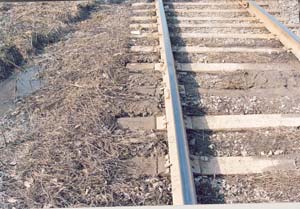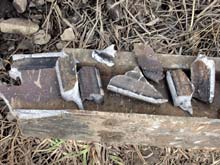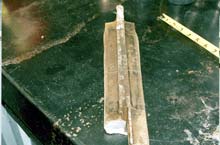Main-track train derailment
St. Lawrence & Atlantic Railroad
Train M394 21-27
Mile 43.93, Sherbrooke Subdivision
Sherbrooke, Quebec
The Transportation Safety Board of Canada (TSB) investigated this occurrence for the purpose of advancing transportation safety. It is not the function of the Board to assign fault or determine civil or criminal liability. This report is not created for use in the context of legal, disciplinary or other proceedings. See Ownership and use of content. Masculine pronouns and position titles may be used to signify all genders to comply with the Canadian Transportation Accident Investigation and Safety Board Act (S.C. 1989, c. 3).
Summary
On 27 March 2003, at approximately 0520 eastern standard time, St. Lawrence & Atlantic Railroad train M394 21-27 was travelling eastward when 11 cars, including one car that was carrying caustic soda, UN 1824, derailed at Mile 43.93, in the municipality of Sherbrooke, in the district of Lennoxville, Quebec. There were no injuries and no spill of dangerous goods. As a precautionary measure, a shopping centre adjacent to the railway right-of-way was evacuated and closed for the morning.
Ce rapport est également disponible en français.
Factual information
St. Lawrence & Atlantic Railroad train M394 21-27 departed Richmond, Quebec, en route to Island Pond, Vermont, United States. It was made up of 4 locomotives and 106 cars and platform cars - 85 loads and 21 empties. It was approximately 6740 feet long and weighed about 8900 tons. The crew consisted of a locomotive engineer and a conductor, both of whom were fully qualified for their respective positions and met rest and fitness requirements.
The trip to Island Pond was routine until Mile 43.93, in the district of Lennoxville, when the train experienced an undesired brake application. The train crew followed the emergency procedures. The conductor inspected the rear of the train and determined that 11 cars (the 84th to the 94th) had derailed on a left-hand curve in the direction of movement near the crossings at Collège Street (Mile 43.84) and Dépôt Street (Mile 43.95). The event recorder indicates that the train was travelling at 26 mph and that the throttle was gradually moved from the No. 7 to the No. 3 position. The train came to a stop following an undesired, train-initiated emergency brake application.
The Sherbrooke Subdivision extends from Island Pond, Vermont (Mile 0.0), to Sainte-Rosalie, Quebec (Mile 110.3). It consists of a single main track. Train movements are governed by the Occupancy Control System (OCS) in accordance with the Canadian Rail Operating Rules (CROR) and are supervised by a rail traffic controller (RTC) based in Auburn, Maine, United States. The track is Class 3, according to Transport Canada's Railway Track Safety Rules (TSR), and the maximum authorized speed in the subdivision is 30 mph for freight trains but, because of road traffic, the maximum authorized speed at the Collège Street crossing is 10 mph. No passenger trains use the subdivision, and the maximum authorized weight of freight cars is 263 000 pounds. Annual tonnage on the track is approximately 2 million gross tons.
The track structure consists mainly of 100-pound jointed rail, in 39-foot lengths, manufactured and laid in 1955. The track was laid on hardwood ties with double-shouldered tie plates secured by four spikes per tie. The rail was box-anchored every third tie. In the derailment area, the ballast was contaminated and waterlogged as the roadbed was not adequately drained (see Photo 1). Evidence of track pumping,Footnote 1 particularly at the approach to the Dépôt Street crossing, was observed.
The head locomotive stopped at Mile 42.32. The first two derailed cars (the 84th and 85th) were platforms C and B of container car TTAX 553649 (see Figure 1). Forty-foot containers were carried on each platform, and the container on platform C weighed about 12 tons. Platforms C and B remained upright and coupled to the front portion of the train. They came to rest approximately 200 m east of the Collège Street crossing and the other derailed cars came to rest to the west of the crossing. The 90th car, MEC 31856, a boxcar, came to rest 2 m from buildings in a shopping centre located to the south of the railway right-of-way. The tank car loaded with caustic soda remained upright and did not leak. Its content was transshipped into tank trucks. A total of 150 m of track was destroyed.
An examination of the first derailed car and the cars ahead of it revealed no discrepancies. Under the last derailed car, the south rail was broken at a joint approximately 30 m east of the Dépôt Street crossing. There were no wheel flange or dragging equipment marks to the west of the joint where the rail was broken. Wheel flange marks were evident to the east of the joint and continued to the trailing truck of the first derailed car (platform C).
Several small fragments of the running surface of the rail and two 75 cm-long pieces of rail were recovered on the east side of the south rail joint. Examination of the recovered broken rail pieces revealed a horizontal fracture of the rail between the head and the web (head-web separation), a vertical fracture in the head, along with transverse cracks (see Photos 2 and 3). The location of the fractures was between the rail joint splice bars, and the fracture surfaces were significantly oxidized. Also, the rail joint bolt holes were ovalized and the spikes that held the rail joint in place were worn. The tie under the east rail end of the joint showed deterioration.
The TSR do not require ongoing testing for internal rail defects on class 1, 2 or 3 tracks not used by passenger trains and with an annual gross tonnage below 25 million tons. However, on the Sherbrooke Subdivision, examination of track geometry and testing are conducted annually. No defects were detected in the derailment area by the rail test car during its most recent inspection on 25 June 2002, by the track geometry car on 14 August 2002, or by the Transport Canada inspection on 07 March 2002. On 26 March 2003, the track foreman conducted his twice-weekly subdivision inspection, and no defects were detected at Mile 43.93.
Analysis
Before the point where track destruction began, there were no marks on the track or roadbed to indicate that a wheel climb had occurred or that equipment failure, such as a broken wheel or axle, had initiated the derailment. Furthermore, examination of the first derailed car and the cars ahead of it revealed no discrepancies. Thus, the analysis will focus on the broken south rail.
Wheel flange marks started at the joint where the south rail broke and continued to the east and to platform C, indicating that the wheels of truck B of this unit derailed some 30 m east of the Dépôt Street crossing over a distance of approximately 370 m. Platform C of car TTAX 553648 first derailed on the south rail, which broke at a joint, and was followed by the 10 other cars.
The heavy oxidation on the surfaces of the rail fractures indicate that the track had pre-existing cracks for some time and gave way under the train. Because of the relatively light weight of the platforms (platform C - 12 tons), it is most likely that the rail failed under the weight of heavier cars that passed before the platforms.
The rail fractures occurred at the rail end, between the rail joint splice bars. Therefore, pre-existing horizontal and vertical rail cracks were not visible and thus would be undetectable during a visual inspection. In addition, the most recent testing of the rails was done in June 2002. Thus, the cracks would have had sufficient time to develop even with the relatively light traffic.
The ballast contamination and state of saturation of the roadbed in the approaches to the Dépôt Street crossing indicate track wear, which leads to additional wheel impacts and abnormal deformation under the cars. Track wear was further confirmed by pumping at the joint of the broken rail, the worn condition of the rail joint spikes and the ovalization of the rail joint bolt holes. The event recorder indicated that the speed of the train was in excess of the speed limit in effect near the Collège Street crossing. Consequently, the forces generated by the axles of this train would have been greater than the forces generated by other trains, explaining why the rail failed under this train.
Findings
Findings as to causes and contributing factors
- Platform C of car TTAX 553648 derailed on the south rail, which broke at a joint, and was followed by the 10 other cars.
- In light of the degraded condition of the approaches to the crossing and the speed of the train, which was in excess of the authorized speed, the rail failed under the forces generated by the axles.
Findings as to risk
- Horizontal and vertical cracks formed between the joint splice bars cannot be detected during a visual inspection.
Other findings
- The rail fractures were discoloured and oxidized, indicating that the cracks had been present for some time.
Safety action taken
On 07 April 2003, St. Lawrence & Atlantic Railroad reduced train speed to 10 mph in all urban areas it serves. The frequency of ongoing inspections by the internal rail defect detection cars and of track geometry testing have been increased to twice annually.
Transport Canada conducted an audit of methods and evaluated the track condition in the Sherbrooke Subdivision. Transport Canada conducted train speed checks using radar in areas in which speed limits are in effect.
This report concludes the Transportation Safety Board's investigation into this occurrence. Consequently, the Board authorized the release of this report on .



